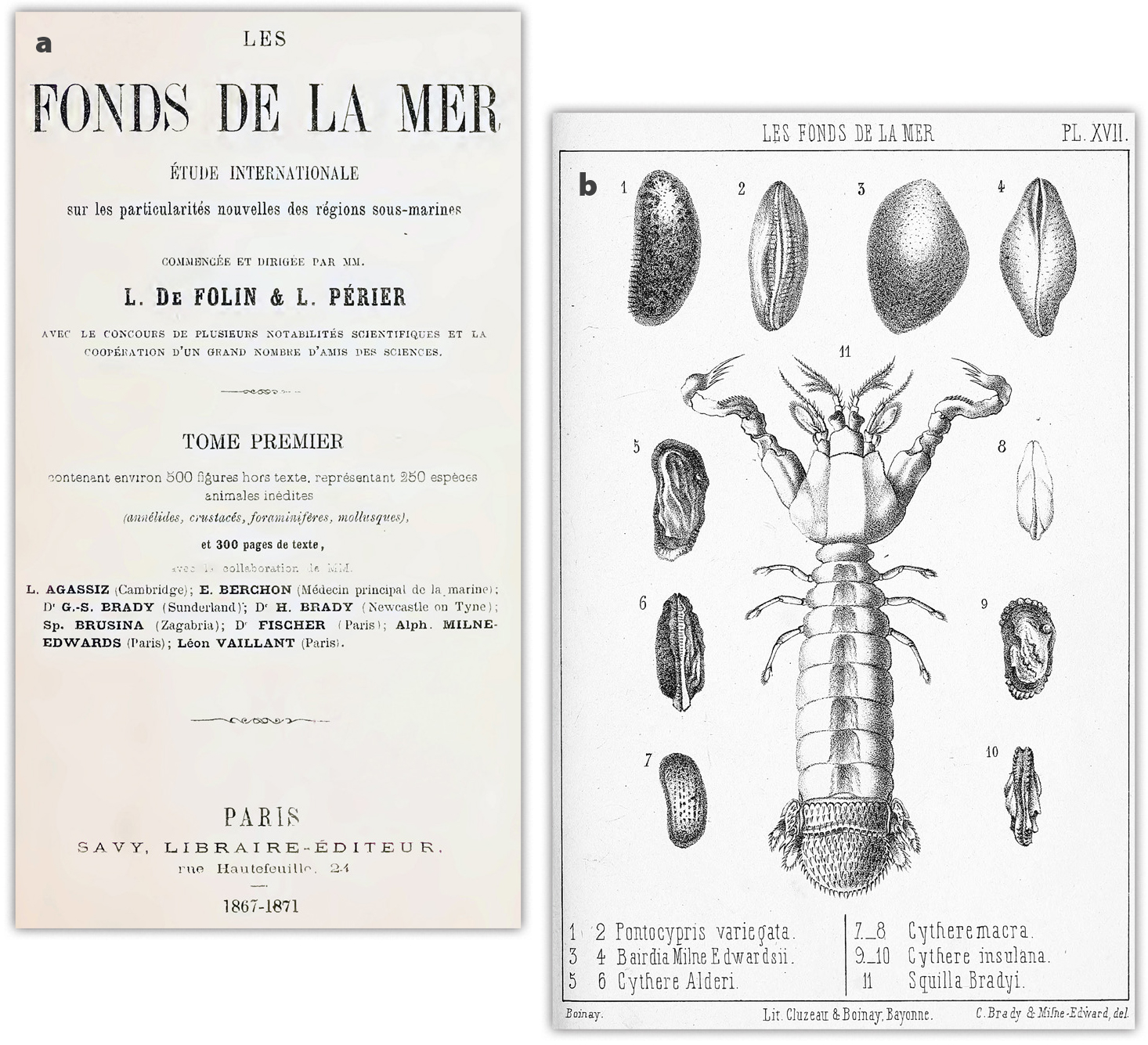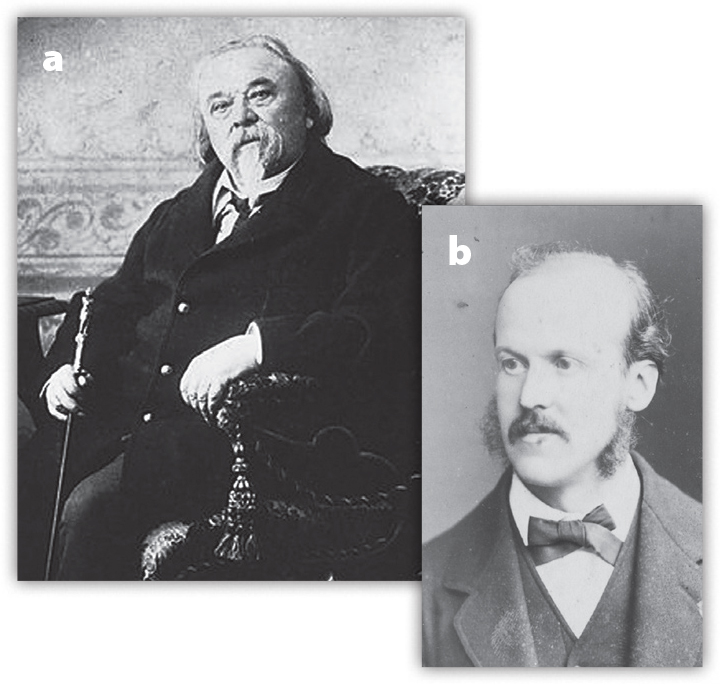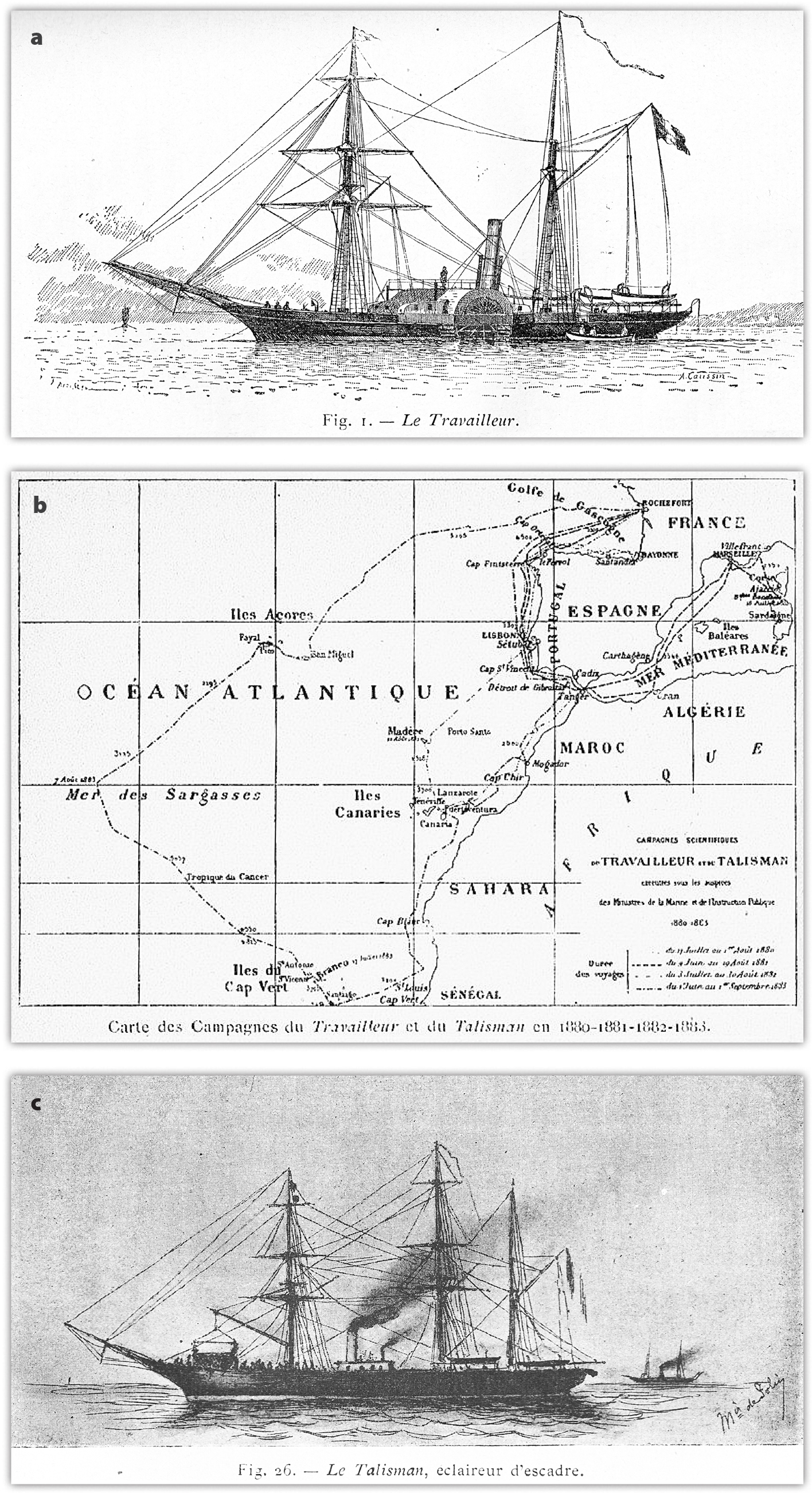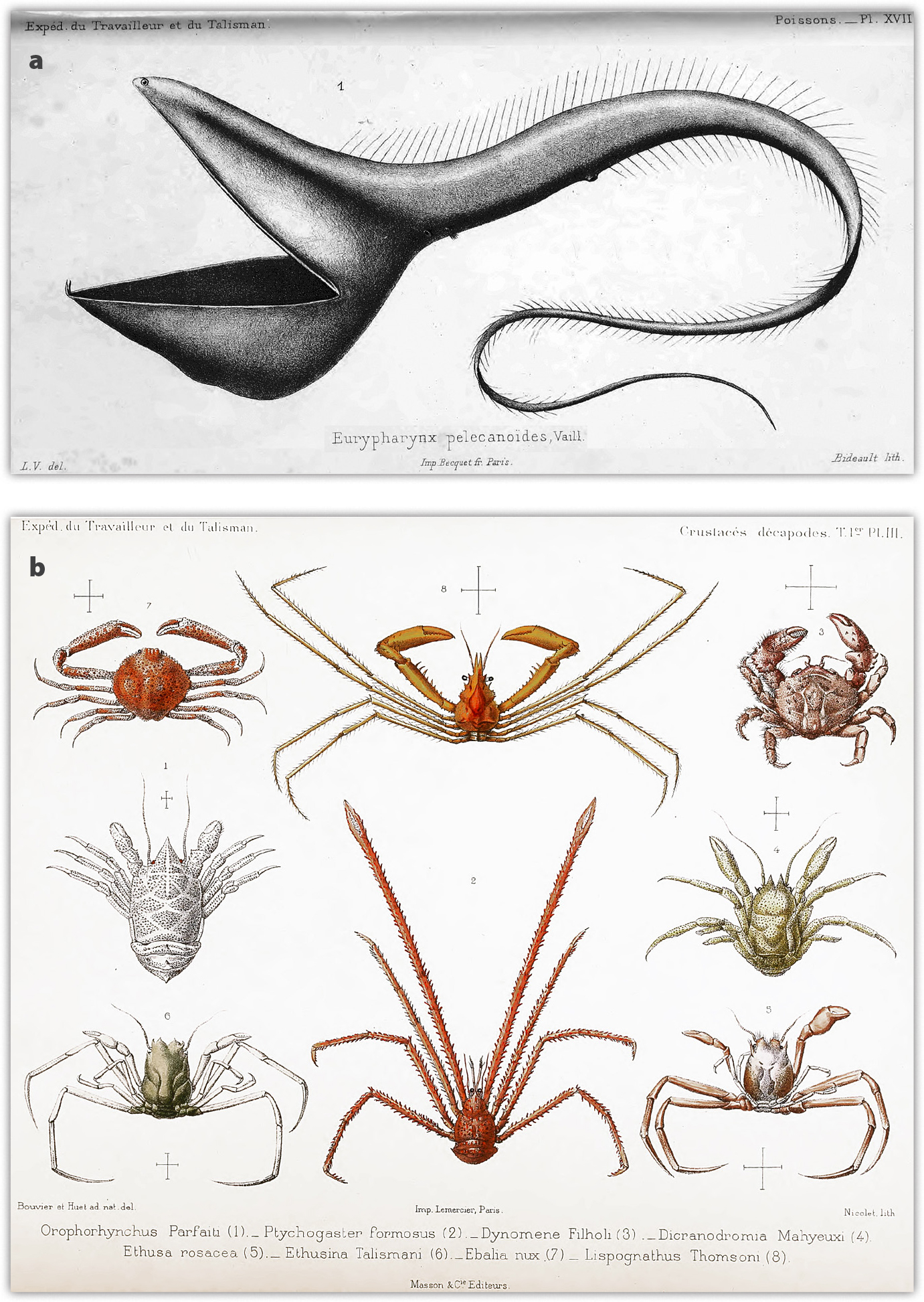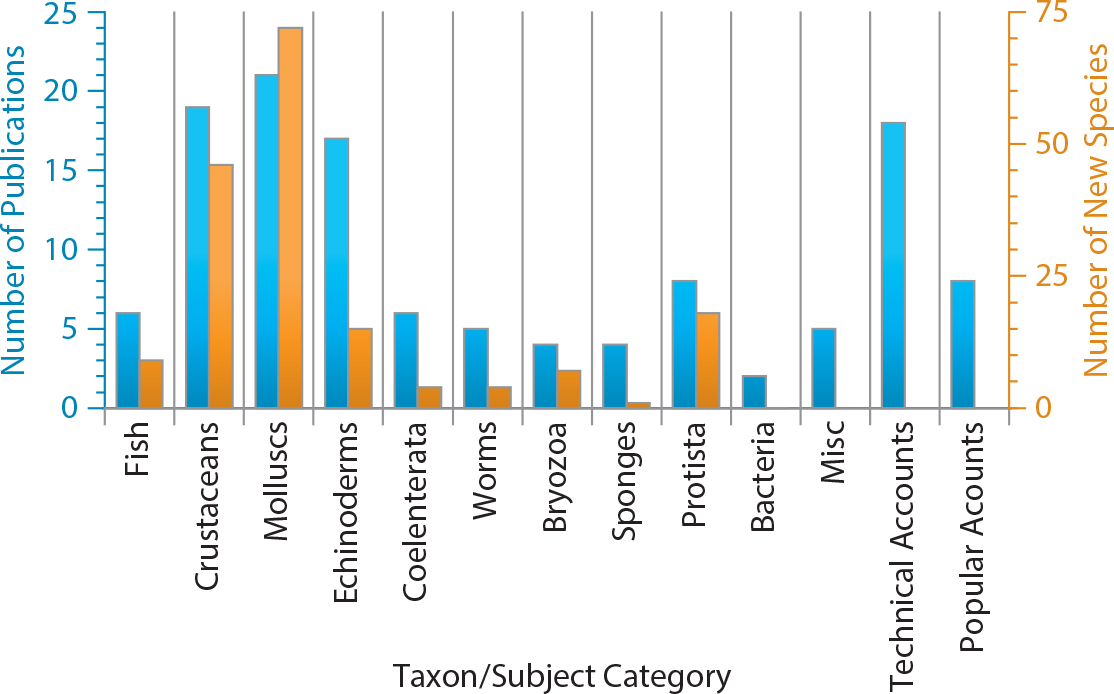Adler, A. 2019. Neptune’s Laboratory: Fantasy, Fear, and Science at Sea. Harvard University Press, Cambridge MA, 241 pp.
Adler, A., and E. Dücker. 2018. When Pasteurian science went to sea: The birth of marine microbiology. Journal of the History of Biology 51:107–138, https://doi.org/10.1007/s10739-017-9477-8.
Anonymous. 1880–1890. Cahiers d’enseignement illustrés. no 4: Explorations sous-marines du Travailleur et du Talisman. L. Bashet, Paris, 16 pp.
Anonymous. 1884a. The deep-sea dredging apparatus of the Talisman; The deep-sea fishes collected by the Talisman; The deep-sea crustacea dredged by the Talisman; The echinoderms dredged by the Talisman. Science, 3:448–455; 3:623–628; 3:713–716; 4:102–105.
Anonymous. 1884b. Un monde sous-marin. Le Temps, number 8314, February 1, 1884, p. 2.
Bartlett, D.H. 2008. Introduction to deep-sea microbiology. Pp 195–201 in High Pressure Microbiology. C. Michaels, D.H. Bartlett, and A. Aertsen, eds, American Society for Microbiology, Washington, DC.
Brady, G.S. 1880. Report on the Ostracoda dredged by H.M.S. Challenger during the years 1873–1876. Pp. 1–184 in Report on the Scientific Results of the Voyage of H.M.S. Challenger. Zoology, Volume 1.
Calvet, L. 1906. Bryozoaires. PP. 355–495 in Expéditions scientifiques du ‘Travailleur’ et du ‘Talisman’ pendant les années 1880, 1881, 1882, 1883, vol. 7.
Carpenter, W.B. 1868. Preliminary report of dredging operations in the seas to the North of the British Islands, carried on in Her Majesty’s Steam-vessel Lightning by Dr. Carpenter and Dr. Wyville Thomson. Proceedings of the Royal Society of London 17:168–200, https://doi.org/10.1098/rspl.1868.0026.
Carpenter, W.B., J.G. Jeffreys, and C.T.W. Thomson. 1870. Preliminary report of the scientific exploration of the deep sea in HM surveying-vessel Porcupine, during the summer of 1869. Proceedings of the Royal Society of London 18:397-492, https://doi.org/10.1098/rspl.1869.0084.
Carpine-Lancre, J. 2001. Oceanographic sovereigns: Prince Albert I of Monaco and King Carlos I of Portugal. Pp. 56–68 in Understanding the Oceans. M. Deaco, T. Rice, and C. Summerhayes, eds, UCL Press, London.
Certes, A. 1884a. Sur la culture, à l’abri des germes atmosphériques, des eaux et des sédiments rapportés par les expéditions du Travailleur et du Talisman. Comptes Rendue Hebdomadaire des Séances de l’Académie des Sciences 98:690–693.
Certes, A. 1884b. Note relative à l’action des hautes pressions sur la vitalité des microorganismes d’eau douce et d’eau de mer. Comptes Rendue Hebdomadaire des Séances de l’Académie des Sciences 99:385–388.
Certes, A., and D. Cochin. 1884. Action des hautes pressions sur la vitalité de la levure et sur les phenomenes de la fermentation. Comptes Rendue Hebdomadaires des Séances et Mémoires de la Sociéte de Biologie, Série 8, n° 36:639–640.
Deacon, M. 1971. Scientists and the Sea 1650–1900: A Study of Marine Science. Aberdeen University Press, Aberdeen, UK, 445 pp.
Dollo, L. 1891. La Vie au Sein des Mers: La faune marine et les grandes profondeurs, les grandes explorations sous marin, les conditions d’existence dans l’abysses, la faune abyssale. Librairie J.-B. Baillière et Fils, Paris, 300 pp.
Filhol, H. 1884. Explorations sous-marines, Voyage du “Talisman”. La Nature, Year 12, 119–122, 134–138, 147–151, 161–164, 182–186, 198–202, 230–234, 278–282, 391–394.
Filhol, H. 1885. La vie au fonds des mers: les explorations sous-marine et les voyages due “Travailleur” et du “Talisman.” Paris, Masson, 301 pp.
Folin, L. 1886. Appendix B. Report on the Caecidae collected by H.M.S. Challenger during the years 1873–76. In Report on the Scientific Results of the Voyage of H.M.S. Challenger During the Years 1873–1876. Zoology 15:681–689.
Folin, L. 1887. Sous les mers Campagnes d’explorations du “Travailleur” et du “Talisman.” Libraire J.-B. Baillière et Fils, Paris, 340 pp.
Folin, L., G.S. Brady, and A. Milne-Edwards. 1869. La rade de Saint-Vincent du Cap-Vert (supplément). Les Fonds de la Mer 1:136–146.
Forbes, E. 1844. Report on the Mollusca and Radiata of the Agean Sea, and on their distribution, considered as bearing on Geology. Pp. 130–193 in Report of the Thirteenth Meeting of the British Association for the Advancement of Science, Cork, August 1883.
Forbes, E., and R. Godwin-Austen. 1859. The Natural History of the European Seas. John Van Voorst, London, 306 pp.
Geistdoerfer, P. 2015. Histoire de l’océanographie: De la surface aux abysses. Nouveau Monde Editions, Paris, 235 pp.
Jannasch, H.W., and C.D. Taylor. 1984. Deep-sea microbiology. Annual Review of Microbiology 38:487–514, https://doi.org/10.1146/annurev.mi.38.100184.002415.
Jeffreys, J.G. 1880. The deep-sea Mollusca of the Bay of Biscay. The Annals and Magazine of Natural History 6:315–319.
Jeffreys, J.G. 1884. The French deep-sea expedition of 1883. Nature 29:216–217, https://doi.org/10.1038/029216b0.
Kofoid, C.A. 1910. The Biological Stations of Europe. United States Bureau of Education, Bulletin No. 4, Whole Number 400. Government Printing Office, Washington, DC, 360 pp.
Laubier, L. 1985. Le program Biogas. Pp. 13–24 in Peuplements Profonds du Golfe de Gascogne. L. Laubier and C. Monniot, eds, Ifremer, Paris, 629 pp.
Laubier, L. 1992. Vingt mille vies sous la mer. Editions Odile Jacob, Paris, 332 pp.
Lacroix, A. 1926. Notice historique sur Alphonse Milne Edwards. Mémoires de l’Academie des Sciences de L’ Institut de France 58:I-LXXIV.
Le Danois, E. 1948. Les Profondeurs de la Mer: Trente ans de recherches sur la faune sou-marine au large des côtes de France. Payot, Paris, 303 pp.
Levin, L.A., and A. Gooday. 2003. The deep Atlantic Ocean. Pp 111–178 in Ecosystems of the Deep Oceans. P.A. Tyler, ed., Elsevier, Amsterdam.
Locard, A. 1897–1898. Mollusques testacés. Expéditions scientifiques du Travailleur et du Talisman pendant les Années 1880, 1881, 1882, et 1883, Masson. vol. 1 [1897], p. 1–516; vol. 2 [1898], p. 1–515.
Menzies, R.J., R.Y. George, and G.T. Rowe. 1973. Abyssal Environment and Ecology of the World Oceans. John Wiley & Sons, New York, 488 pp.
Mills, E.L. 1983. Problems of deep-sea biology: An historical perspective. Pp 1–79 in The Sea. G.T. Rowe, ed., John Wiley & Sons, San Francisco.
Mills, E.L. 2009. The Fluid Envelope of Our Planet: How the Study of Currents Became a Science. University of Toronto Press, Toronto, 433 pp.
Milne Edwards, A. 1861. Observations sur l’existence de divers mollusques et zoophyes à de très grandes profondeurs dans la Mer Méditerranée. Annales des Sciences Naturelles, Serie 4, Zoologie 15:149–157.
Milne Edwards, A. 1881. Rapport sur les travaux de la commision chargé par M. le Ministre de l’Instruction Publique d’étudier la faune sous-marine dans les grandes profoneurs du Golfe de Gascogne. Archives des Missions Scientifiques et Littéraires 7:421–431.
Milne-Edwards, A. 1882. Les explorations sous-marines du Travailleur dans l’Océan Atlantique et dans la Méditerranée en 1880 et 1881. Bulletin de la Sociéte de Géographie 3:93–130.
Milne Edwards, A., and Bouvier, E.L. 1900. Heterocarpus grimaldii, espèce nouvelle recueillie par le “Talisman,” ”l’Hirondelle” et la ”Princesse Alice.” Bulletin de la Société Zoologique de France 25:58.
Norman, A.M. 1880. Notes on the French explorations of “Le Travailleur” in the Bay of Biscay. Annals and Magazine of Natural History 36:430–436.
Perrier, E. 1886. Les Explorations Sous-Marines. Hachette, Paris, 352 pp.
Perrier, E. 1891. Les Explorations Sous-Marines, 2nd ed. Paris, Hachette, 352 pp.
Perrier, E. 1899. Les Explorations Sous-Marines, 3rd ed. Paris, Hachette, 352 pp.
Rice, A.L., H.L. Burstyn, and A.G.E. Jones. 1976. G.C. Wallich M.D. – megalomanic or mis-used oceanographic genius? Journal of the Society for the Bibliography of Natural History 7:423–450, https://doi.org/10.3366/jsbnh.1976.7.4.423.
Saldanha, L. 2002. The discovery of the deep-sea Atlantic fauna. Pp. 235–247 in Oceanographic History: The Pacific and Beyond. K.R. Benson and P.F. Rehbock, eds, University of Washington Press, Seattle.
Sears, M., and D. Merriman, eds. 1980. Oceanography: The Past. Springer-Verlag, New York, 812 pp.
Thomson, C.W. 1873. The Depths of the Sea: An Account of the General Results of the Dredging Cruises of H.M.S.S. Porcupine and Lightning During the Summer of 1868, 1869, and 1870, Under the Scientific Direction of Dr. Carpenter, F.R.S., J. Gwyn Jeffreys, F.R.S., and Dr. Wyville Thomson, F.R.S. Macmillan, London, 527 pp,
Thomson, C.W. 1878. The Voyage of the Challenger: The Atlantic: A preliminary Account of the General Results of The Exploring Voyage of H.M.S. Challenger During the Year 1873 and the Early Part of the Year 1876. Harper, New York, vol. 1, 391 pp., vol. 2, 340 pp.
Vaughan, T.W. 1937. International Aspects of Oceanography. Oceanographic Data and Provisions for Oceanographic Research. National Academy of Sciences, Washington, DC, 225 pp.
Wallich, G.C. 1860. Notes on the Presence of Animal Life at Vast Depths in the Sea; With Observations on the Nature of the Sea Bed, as Bearing on Submarine Telegraphy. Taylor and Francis, London, 38 pp.
Wüst, G. 1964. The major deep-sea expeditions and research vessels 1873–1960: A contribution to the history of oceanography. Progress in Oceanography 2:1–52, https://doi.org/10.1016/0079-6611(64)90002-3.
Zobell, C.E. 1952. Bacterial life at the bottom of the Philippine Trench. Science 115:507–508, https://doi.org/10.1126/science.115.2993.507.


